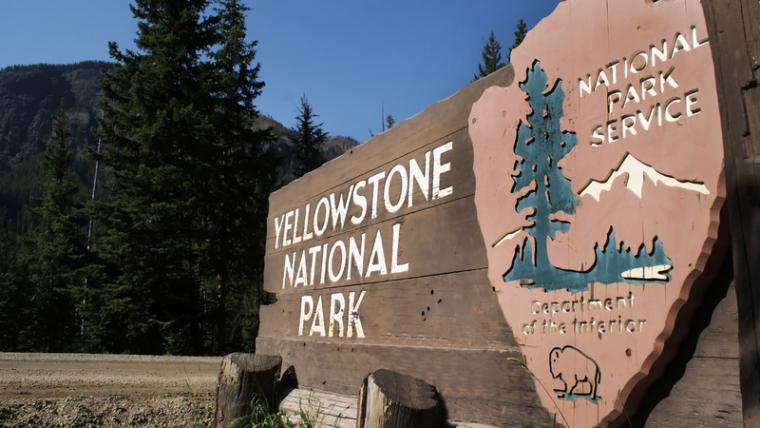
And to think we are usually more worried about littering, loitering and feeding the wildlife.
After 10,000 visitors were evacuated from Yellowstone National Park in Mammoth Hot Springs, Wyoming in mid-June because of record flooding, the country’s second-most visited national park partially reopened June 22. But the damage wrought by Mother Nature could have long-term effects.
The floods, caused by heavy rains across northern Wyoming and southern Montana that accelerated spring snowmelt, “reshaped the park’s rivers and canyons, wiped out numerous roads and left some areas famous for their wildlife viewing inaccessible, possibly for months,” the Associated Press reports.
The park’s southern loop, which includes the legendary Old Faithful geyser, is among the areas that reopened.
 “The reopening comes as officials in Yellowstone are still tallying the extent of the damage,” according to the AP. “Based on other national park disasters, it could take years and carry a steep price tag to rebuild. It’s an environmentally sensitive landscape with a huge underground plumbing system that feeds into the park’s geysers, hot springs and other thermal features. Construction season only runs from the spring thaw until the first snowfall, a narrow window that means some roads could receive only temporary fixes this year.”
“The reopening comes as officials in Yellowstone are still tallying the extent of the damage,” according to the AP. “Based on other national park disasters, it could take years and carry a steep price tag to rebuild. It’s an environmentally sensitive landscape with a huge underground plumbing system that feeds into the park’s geysers, hot springs and other thermal features. Construction season only runs from the spring thaw until the first snowfall, a narrow window that means some roads could receive only temporary fixes this year.”
What all this means for sports tourism in and around the park remains to be seen. But early reports from hotel and tourist attraction operators in those communities suggest a bleak outlook for at least part of the rest of 2022.
“There’s nobody here,” Kari Huesing, office manager of Yellowstone Gateway Inn in Gardiner, Mont., told CNN.com. “We were booked solid for a year.” A neighboring hotel actually shut down and sent employees home after the flooding, as did other lodging facilities in the area.
“The summer that we prepared for is not at all similar to the summer that we’re going to have,” Cara McGary, a nature guide who leads groups through Wyoming’s Lamar Valley to view wildlife, told the AP. “This is an 80% to 100% loss of business during the high season.”
“What we’ve been through the last couple years, it’s almost biblical,” Colin Davis, owner of Chico Hot Springs Resort & Day Spa in Emigrant, Mont., told The Washington Post.
Yet in Casper, Wyo., a gateway to Yellowstone that nevertheless is located further from the park than both Gardiner and Emigrant, some lodging operators reported brisk business after Yellowstone visitors needed to change their plans.
The park is coming off a record 2021, with nearly 4.9 million visitors. That was up from 3.8 million during the pandemic year of 2020 and up from 4 million in 2019 According to the National Park Service, $642 million was pumped into the collective local economy of communities near the park in 2019, supporting 7,000 jobs. Prior to the flooding, park officials were anticipating that the number of visitors this year would surpass $5 million; June historically is one of the park’s busiest months.
Meanwhile, National Park Service Director Chuck Sams and Yellowstone National Park Superintendent Cam Sholly recently announced a $50 million recovery effort. By early July, cleanup, repairs and final inspections of the northern loop infrastructures are expected to be completed — allowing for visitor access to approximately 80 percent of the park.
The initial $50 million will be used to restore temporary access to Gardiner and Cooke City, Mont., plus additional sites. In partnership with the Federal Highway Administration, road construction crews and materials that already were in the park for a previously scheduled road project to repair 22 miles of the Grand Loop Road between Old Faithful and West Thumb Geyser Basin will be diverted to repairing Old Gardiner Road — thus ensuring that essential emergency services, food, supplies and other administrative needs will be available throughout the winter.
Additionally, NPS reports that emergency environmental and historic preservation compliance is underway in accordance with the National Historic Preservation and Environmental Policy Acts. Permanent reconstruction options are being developed and alternatives will be completed in the upcoming months.
In recent years, Yellowstone has completed more than $100 million in projects to improve transportation infrastructure, reduce traffic congestion and enhance visitor experiences.

